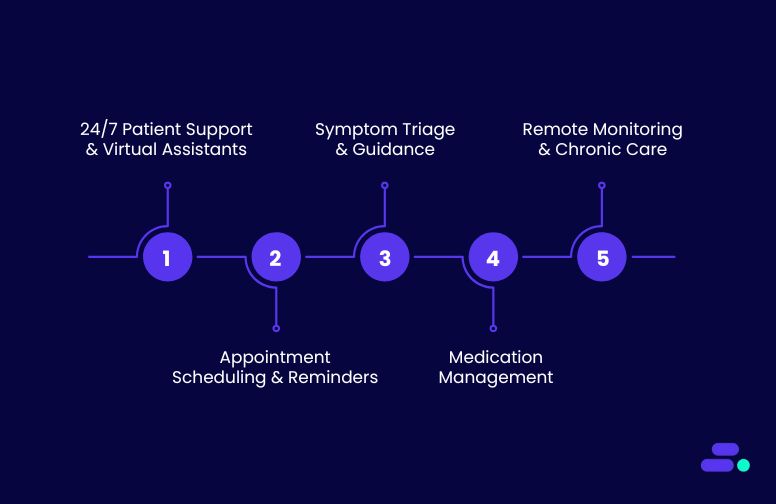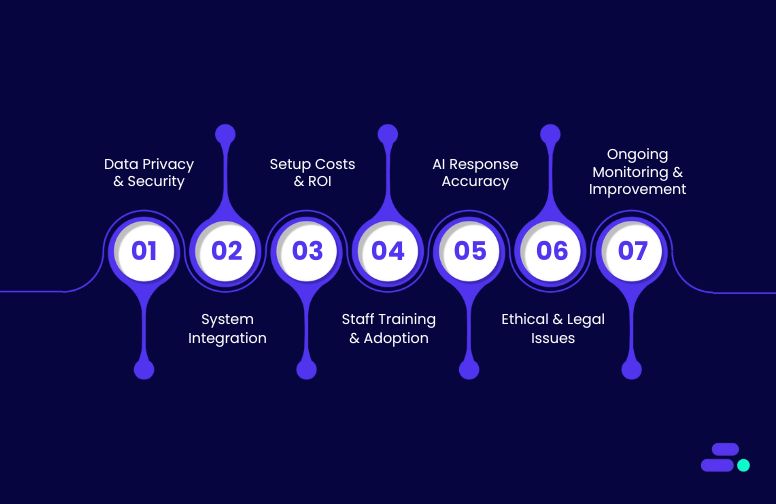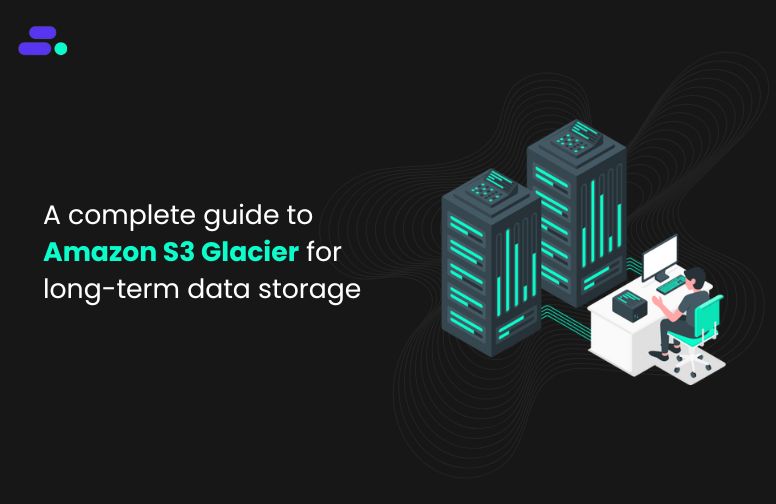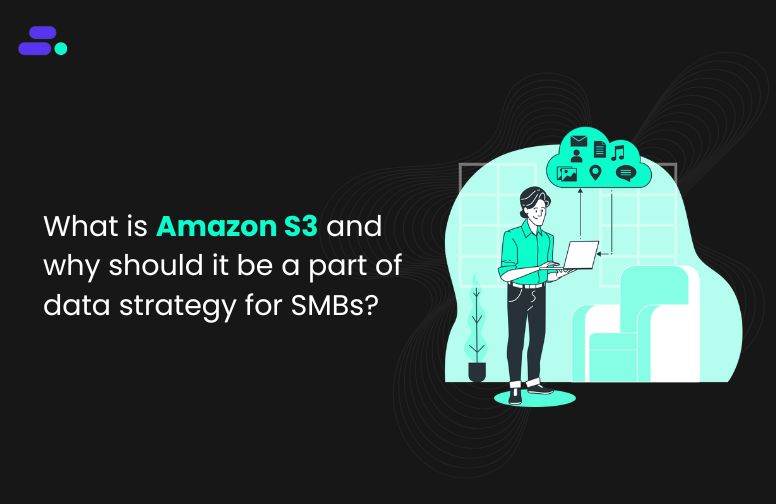This is a div block with a Webflow interaction that will be triggered when the heading is in the view.

Modernize your cloud. Maximize business impact.
From sales transactions to operational logs, businesses now handle millions of data points daily. Yet when it’s time to pull insights, most find their traditional databases too slow, rigid, or costly for complex analytics.
Without scalable infrastructure, even basic reporting turns into a bottleneck. SMBs often operate with lean teams, limited budgets, and rising compliance demands, leaving little room for overengineered systems or extended deployment cycles.
Amazon Redshift from AWS changes that. As a fully managed cloud data warehouse, it enables businesses to query large volumes of structured and semi-structured data quickly without the need to build or maintain underlying infrastructure. Its decoupled architecture, automated tuning, and built-in security make it ideal for SMBs looking to modernize fast.
This guide breaks down how Amazon Redshift works, how it scales, and why it’s become a go-to analytics engine for SMBs that want enterprise-grade performance without the complexity.
Key Takeaways
- End-to-end analytics without infrastructure burden: Amazon Redshift eliminates the need for manual cluster management and scales computing and storage independently, making it ideal for growing teams with limited technical overhead.
- Built-in cost efficiency: With serverless billing, reserved pricing, and automatic concurrency scaling, Amazon Redshift enables businesses to control costs without compromising performance.
- Security built for compliance-heavy industries: Data encryption, IAM-based access control, private VPC deployment, and audit logging provide the safeguards required for finance, healthcare, and other regulated environments.
- AWS ecosystem support: Amazon Redshift integrates with Amazon S3, Kinesis, Glue, and other AWS services, making it easier to build real-time or batch data pipelines without requiring additional infrastructure layers.
- Faster rollout with Cloudtech: Cloudtech’s AWS-certified experts help SMBs deploy Amazon Redshift with confidence, handling everything from setup and tuning to long-term optimization and support.
What is Amazon Redshift?
Amazon Redshift is built to support analytical workloads that demand high concurrency, low-latency queries, and scalable performance. It processes both structured and semi-structured data using a columnar storage engine and a massively parallel processing (MPP) architecture, making it ideal for businesses, especially SMBs, that handle fast-growing datasets.
It separates compute and storage layers, allowing organizations to scale each independently based on workload requirements and cost efficiency. This decoupled design supports a range of analytics, from ad hoc dashboards to complex modeling, without burdening teams with the maintenance of infrastructure.
Core capabilities and features of Amazon Redshift

Amazon Redshift combines a high-performance architecture with intelligent automation to support complex analytics at scale, without the burden of manual infrastructure management. From optimized storage to advanced query handling, it equips SMBs with tools to turn growing datasets into business insights.
1. Optimized architecture for analytics
Amazon Redshift stores data in a columnar format, minimizing I/O and reducing disk usage through compression algorithms like LZO, ZSTD, and AZ64. Its Massively Parallel Processing (MPP) engine distributes workloads across compute nodes, enabling horizontal scalability for large datasets. The SQL-based interface supports PostgreSQL-compatible JDBC and ODBC drivers, making it easy to integrate with existing BI tools.
2. Machine learning–driven performance
The service continuously monitors historical query patterns to optimize execution plans. It automatically adjusts distribution keys, sort keys, and compression settings—eliminating the need for manual tuning. Result caching, intelligent join strategies, and materialized views further improve query speed.
3. Serverless advantages for dynamic workloads
Amazon Redshift Serverless provisions and scales compute automatically based on workload demand. With no clusters to manage, businesses benefit from zero administration, fast start-up via Amazon Redshift Query Editor v2, and cost efficiency through pay-per-use pricing and automatic pause/resume functionality.
4. Advanced query capabilities across sources
Amazon Redshift supports federated queries to join live data from services like Amazon Aurora, RDS, and DynamoDB—without moving data. Amazon Redshift Spectrum extends this with the ability to query exabytes of data in Amazon S3 using standard SQL, reducing cluster load. Cross-database queries simplify analysis across schemas, and materialized views ensure fast response for repeated metrics.
5. Performance at scale
To maintain responsiveness under load, Amazon Redshift includes concurrency scaling, which provisions temporary clusters when query queues spike. Workload management assigns priorities and resource limits to users and applications, ensuring a fair distribution of resources. Built-in optimization engines maintain consistent performance as usage increases.
Amazon Redshift setup and deployment process
Successfully deploying Amazon Redshift begins with careful preparation of AWS infrastructure and security settings. These foundational steps ensure that the data warehouse operates securely, performs reliably, and integrates well with existing environments.
The process involves configuring identity and access management, network architecture, selecting the appropriate deployment model, and completing critical post-deployment tasks.
1. Security and network prerequisites for Amazon Redshift deployment
Before provisioning clusters or serverless workgroups, organizations must establish the proper security and networking foundation. This involves setting permissions, preparing network isolation, and defining security controls necessary for protected and compliant operations.
- IAM configuration: Assign IAM roles with sufficient permissions to manage Amazon Redshift resources. The Amazon Redshift Full Access policy covers cluster creation, database admin, and snapshots. For granular control, use custom IAM policies with resource-based conditions to restrict access by cluster, database, or action.
- VPC network setup: Deploy Amazon Redshift clusters within dedicated subnets in a VPC spanning multiple Availability Zones (AZs) for high availability. Attach security groups that enforce strict inbound/outbound rules to control communication and isolate the environment.
- Security controls: Limit access to Amazon Redshift clusters through network-level restrictions. Inbound traffic on port 5439 (default) must be explicitly allowed only from trusted IPs or CIDR blocks. Outbound rules should permit necessary connections to client apps and related AWS services.
2. Deployment models in Amazon Redshift
Once the security and network prerequisites are in place, organizations can select the deployment model that best suits their operational needs and workload patterns. Amazon Redshift provides two flexible options that differ in management responsibility and scalability:
- Amazon Redshift Serverless: It eliminates infrastructure management by auto-scaling compute based on query demand. Capacity, measured in Amazon Redshift Processing Units (RPUs), adjusts dynamically within configured limits, helping organizations balance performance and cost.
- Provisioned clusters: Designed for predictable workloads, provisioned clusters offer full control over infrastructure. A leader node manages queries, while compute nodes process data in parallel. With RA3 node types, compute and storage scale independently for greater efficiency.
3. Initial configuration tasks for Amazon Redshift
After selecting a deployment model and provisioning resources, several critical configuration steps must be completed to secure, organize, and optimize the Amazon Redshift environment for production use.
- Database setup: Each Amazon Redshift database includes schemas that group tables, views, and other objects. A default PUBLIC schema is provided, but up to 9,900 custom schemas can be created per database. Access is controlled using SQL to manage users, groups, and privileges at the schema and table levels.
- Network security: Updated security group rules take effect immediately. Inbound and outbound traffic permissions must support secure communication with authorized clients and integrated AWS services.
- Backup configuration: Amazon Redshift captures automated, incremental backups with configurable retention from 1 to 35 days. Manual snapshots support point-in-time recovery before schema changes or key events. Cross-region snapshot copying enables disaster recovery by replicating backups across AWS regions.
- Parameter management: Cluster parameter groups define settings such as query timeouts, memory use, and connection limits. Custom groups help fine-tune behavior for specific workloads without impacting other Amazon Redshift clusters in the account.
With the foundational setup, deployment model, and initial configuration complete, the focus shifts to how Amazon Redshift is managed in production, enabling efficient scaling, automation, and deeper enterprise integration.
Post-deployment operations and scalability in Amazon Redshift
Amazon Redshift offers flexible deployment options through both graphical interfaces and programmatic tools. Organizations can choose between serverless and provisioned cluster management based on the predictability of their workloads and resource requirements. The service provides comprehensive management capabilities that automate routine operations while maintaining control over critical configuration parameters.
1. Provision of resources and management functionalities
Getting started with Amazon Redshift involves selecting the right provisioning approach. The service supports a range of deployment methods to align with organizational preferences, from point-and-click tools to fully automated DevOps pipelines.
- AWS Management Console: The graphical interface provides step-by-step cluster provisioning with configuration wizards for network settings, security groups, and backup preferences. Organizations can launch clusters within minutes using pre-configured templates for everyday use cases.
- Infrastructure as Code: AWS CloudFormation and Terraform enable automated deployment across environments. Templates define cluster specs, security, and networking to ensure consistent, repeatable setups..
- AWS Command Line Interface: Programmatic cluster management through CLI commands supports automation workflows and integration with existing DevOps pipelines. It offers complete control over cluster lifecycle operations, including creation, modification, and deletion.
- Amazon Redshift API: Direct API access allows integration with enterprise systems for custom automation workflows. RESTful endpoints enable organizations to embed Amazon Redshift provisioning into broader infrastructure management platforms.
2. Dynamic scaling capabilities for Amazon Redshift workloads
Once deployed, Amazon Redshift adapts to dynamic workloads using several built-in scaling mechanisms. These capabilities help maintain query performance under heavy loads and reduce costs during periods of low activity.
- Concurrency Scaling: Automatically provisions additional compute clusters when query queues exceed thresholds. These temporary clusters process queued queries independently, preventing performance degradation during spikes.
- Elastic Resize: Enables fast adjustment of cluster node count to match changing capacity needs. Organizations can scale up or down within minutes without affecting data integrity or system availability.
- Pause and Resume: Provisioned clusters can be suspended during idle periods to save on computing charges. The cluster configuration and data remain intact and are restored immediately upon resumption.
- Scheduled Scaling: Businesses can define policies to scale resources in anticipation of known usage patterns, allowing for more efficient resource allocation. This approach supports cost control and ensures performance during recurring demand cycles.
3. Unified analytics with Amazon Redshift
Beyond deployment and scaling, Amazon Redshift acts as a foundational analytics layer that unifies data across systems and business functions. It is frequently used as a core component of modern data platforms.
- Enterprise data integration: Organizations use Amazon Redshift to consolidate data from CRM, ERP, and third-party systems. This centralization breaks down silos and supports organization-wide analytics and reporting.
- Multi-cluster environments: Teams can deploy separate clusters for different departments or applications, allowing for greater flexibility and scalability. This enables workload isolation while allowing for shared insights when needed through cross-cluster queries.
- Hybrid storage models: By combining Amazon Redshift with Amazon S3, organizations optimize both performance and cost. Active datasets remain in cluster storage, while historical or infrequently accessed data is stored in cost-efficient S3 data lakes.
After establishing scalable operations and integrated data workflows, organizations must ensure that these environments remain secure, compliant, and well-controlled, especially when handling sensitive or regulated data.
Security and connectivity features in Amazon Redshift

Amazon Redshift enforces strong security measures to protect sensitive data while enabling controlled access across users, applications, and networks. Security implementation encompasses data protection, access controls, and network isolation, all of which are crucial for organizations operating in regulated industries, such as finance and healthcare. Connectivity is supported through secure, standards-based drivers and APIs that integrate with internal tools and services.
1. Data security measures using IAM and VPC
Amazon Redshift integrates with AWS Identity and Access Management (IAM) and Amazon Virtual Private Cloud (VPC) to provide fine-grained access controls and private network configurations.
- IAM integration: IAM policies allow administrators to define permissions for cluster management, database operations, and administrative tasks. Role-based access ensures that users and services access only the data and functions for which they are authorized.
- Database-level security: Role-based access at the table and column levels allows organizations to enforce granular control over sensitive datasets. Users can be grouped by function, with each group assigned specific permissions.
- VPC isolation: Clusters are deployed within private subnets, ensuring network isolation from the public internet. Custom security groups define which IP addresses or services can communicate with the cluster.
- Multi-factor authentication: To enhance administrative security, Amazon Redshift supports multi-factor authentication through AWS IAM, requiring additional verification for access to critical operations.
2. Encryption for data at rest and in transit
Amazon Redshift applies end-to-end encryption to protect data throughout its lifecycle.
- Encryption at rest: All data, including backups and snapshots, is encrypted using AES-256 via AWS Key Management Service (KMS). Organizations can use either AWS-managed or customer-managed keys for encryption and key lifecycle management.
- Encryption in transit: TLS 1.2 secures data in motion between clients and Amazon Redshift clusters. SSL certificates are used to authenticate clusters and ensure encrypted communication channels.
- Certificate validation: SSL certificates also protect against spoofed endpoints by validating cluster identity, which is essential when connecting through external applications or secure tunnels.
3. Secure connectivity options for Amazon Redshift access
Amazon Redshift offers multiple options for secure access across application environments and user workflows.
- JDBC and ODBC drivers: Amazon Redshift supports industry-standard drivers that include encryption, connection pooling, and compatibility with a wide range of internal applications and SQL-based tools.
- Amazon Redshift Data API: This HTTP-based API allows developers to run SQL queries without maintaining persistent database connections. IAM-based authentication ensures secure, programmatic access for automated workflows.
- Query Editor v2: A browser-based interface that allows secure SQL query execution without needing to install client drivers. It supports role-based access and session-level security settings to maintain administrative control.
Integration and data access in Amazon Redshift
Amazon Redshift offers flexible integration options designed for small and mid-sized businesses that require efficient and scalable access to both internal and external data sources. From real-time pipelines to automated reporting, the platform streamlines how teams connect, load, and work with data, eliminating the need for complex infrastructure or manual overhead.
1. Simplified access through Amazon Redshift-native tools
For growing teams that need to analyze data quickly without relying on a heavy setup, Amazon Redshift includes direct access methods that reduce configuration time.
- Amazon Redshift Query Editor v2: A browser-based interface that allows teams to run SQL queries, visualize results, and share findings, all without installing drivers or maintaining persistent connections.
- Amazon Redshift Data API: Enables secure, HTTP-based query execution in serverless environments. Developers can trigger SQL operations directly from applications or scripts using IAM-based authentication, which is ideal for automation.
- Standardized driver support: Amazon Redshift supports JDBC and ODBC drivers for internal tools and legacy systems, providing broad compatibility for teams using custom reporting or dashboard solutions.
2. Streamlined data pipelines from AWS services
Amazon Redshift integrates with core AWS services, enabling SMBs to manage both batch and real-time data without requiring extensive infrastructure.
- Amazon S3 with Amazon Redshift Spectrum: Enables high-throughput ingestion from S3 and allows teams to query data in place, avoiding unnecessary transfers or duplications.
- AWS Glue: Provides visual tools for setting up extract-transform-load (ETL) workflows, reducing the need for custom scripts. Glue Data Catalog centralizes metadata, making it easier to manage large datasets.
- Amazon Kinesis: Supports the real-time ingestion of streaming data for use cases such as application telemetry, customer activity tracking, and operational metrics.
- AWS Database Migration Service: Facilitates low-downtime migration from existing systems to Amazon Redshift. Supports ongoing replication to keep cloud data current without disrupting operations.
3. Built-in support for automated reporting and dashboards
Amazon Redshift supports organizations that want fast, accessible insights without investing in separate analytics platforms.
- Scheduled reporting: Teams can automate recurring queries and export schedules to keep stakeholders updated without manual intervention.
- Self-service access: Amazon Redshift tools support role-based access, allowing non-technical users to run safe, scoped queries within approved datasets.
- Mobile-ready dashboards: Reports and result views are accessible on tablets and phones, helping teams track KPIs and metrics on the go.
Cost and operational factors in Amazon Redshift
For SMBs, cost efficiency and operational control are central to maintaining a scalable data infrastructure. Amazon Redshift offers a flexible pricing model, automatic performance tuning, and predictable maintenance workflows, making it practical to run high-performance analytics without overspending or overprovisioning.
Pricing models tailored to usage patterns
Amazon Redshift supports multiple pricing structures designed for both variable and predictable workloads. Each model offers different levels of cost control and scalability, allowing organizations to align infrastructure spending with business goals.
- Capacity-based pricing: Amazon Redshift follows a capacity-based pricing model where businesses pay for the compute capacity (measured in Redshift Processing Units or RPUs) that is provisioned.
- Reserved instance pricing: For businesses with consistent query loads, reserved instances offer savings through 1-year or 3-year commitments. This approach provides budget predictability and cost reduction for steady usage.
- Serverless pricing model: Amazon Redshift Serverless charges based on Amazon Redshift Processing Units (RPUs) consumed during query execution. Since computing pauses during idle time, organizations avoid paying for unused capacity.
- Concurrency scaling credits: When demand spikes, Amazon Redshift spins up additional clusters automatically. Most accounts receive sufficient free concurrency scaling credits to handle typical peak periods without incurring extra costs.
Operational workflows for cluster management
Amazon Redshift offers streamlined workflows for managing cluster operations, ensuring consistent performance, and minimizing the impact of maintenance tasks on business-critical functions.
- Lifecycle control: Clusters can be launched, resized, paused, or deleted using the AWS Console, CLI, or API. Organizations can scale up or down as needed without losing data or configuration.
- Maintenance schedule: Software patches and system updates are applied during customizable maintenance windows to avoid operational disruption.
- Backup and Restore: Automated, incremental backups provide continuous data protection with configurable retention periods. Manual snapshots can be triggered for specific restore points before schema changes or major updates.
- Monitoring and diagnostics: Native integration with Amazon CloudWatch enables visibility into query patterns, compute usage, and performance bottlenecks. Custom dashboards help identify resource constraints early.
Resource optimization within compute nodes
Efficient resource utilization is crucial for maintaining a balance between cost and performance, particularly as data volumes expand and the number of concurrent users increases.
- Compute and storage configuration: Organizations can choose from node types, including RA3 instances that decouple compute from storage. This allows independent scaling based on workload needs.
- Workload management policies: Amazon Redshift supports queue-based workload management, which assigns priority and resource caps to different users or jobs. This ensures that lower-priority operations do not delay time-sensitive queries.
- Storage compression: Data is stored in columnar format with automatic compression, significantly reducing storage costs while maintaining performance.
- Query tuning automation: Amazon Redshift recommends materialized views, caches common queries, and continuously adjusts query plans to reduce compute time, enabling businesses to achieve faster results with lower operational effort.
While Amazon Redshift delivers strong performance and flexibility, many SMBs require expert help to handle implementation complexity, align the platform with business goals, and ensure compliant, growth-oriented outcomes.
How Cloudtech accelerates Amazon Redshift implementation
Cloudtech is a specialized AWS consulting partner dedicated to helping businesses address the complexities of cloud adoption and modernization with practical, secure, and scalable solutions.
Many businesses face challenges in implementing enterprise-grade data warehousing due to limited resources and evolving analytical demands. Cloudtech fills this gap by providing expert guidance and hands-on support, ensuring businesses can confidently deploy Amazon Redshift while maintaining control and compliance.
Cloudtech's team of former AWS employees delivers comprehensive data modernization services that minimize risk and ensure cloud analytics support business objectives:
- Data modernization: Upgrading data infrastructures for improved performance and analytics, helping businesses unlock more value from their information assets through Amazon Redshift implementation.
- Application modernization: Revamping legacy applications to become cloud-native and scalable, ensuring seamless integration with modern data warehouse architectures.
- Infrastructure and resiliency: Building secure, resilient cloud infrastructures that support business continuity and reduce vulnerability to disruptions through proper Amazon Redshift deployment and optimization.
- Generative artificial intelligence: Implementing AI-driven solutions that leverage Amazon Redshift's analytical capabilities to automate and optimize business processes.
Conclusion
Amazon Redshift provides businesses with a secure and scalable foundation for high-performance analytics, eliminating the need to manage infrastructure. With automated optimization, advanced security, and flexible pricing, it enables data-driven decisions across teams while keeping costs under control.
For small and mid-sized organizations, partnering with Cloudtech streamlines the implementation process. Our AWS-certified team helps you plan, deploy, and optimize Amazon Redshift to meet your specific performance and compliance goals. Get in touch with us to get started today!
FAQ’s
1. What is the use of Amazon Redshift?
Amazon Redshift is used to run high-speed analytics on large volumes of structured and semi-structured data. It helps businesses generate insights, power dashboards, and handle reporting without managing traditional database infrastructure.
2. Is Amazon Redshift an ETL tool?
No, Amazon Redshift is not an ETL tool. It’s a data warehouse that works with ETL services like AWS Glue to store and analyze transformed data efficiently for business intelligence and operational reporting.
3. What is the primary purpose of Amazon Redshift?
Amazon Redshift’s core purpose is to deliver fast, scalable analytics by running complex SQL queries across massive datasets. It supports use cases like customer insights, operational analysis, and financial forecasting across departments.
4. What is the best explanation of Amazon Redshift?
Amazon Redshift is a managed cloud data warehouse built for analytics. It separates computing and storage, supports standard SQL, and enables businesses to scale performance without overbuilding infrastructure or adding operational overhead.
5. What is Amazon Redshift best for?
Amazon Redshift is best for high-performance analytical workloads, powering dashboards, trend reports, and data models at speed. It’s particularly useful for SMBs handling growing data volumes across marketing, finance, and operations.

Get started on your cloud modernization journey today!
Let Cloudtech build a modern AWS infrastructure that’s right for your business.

















